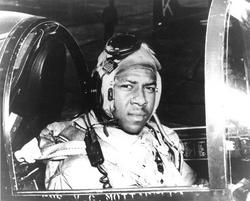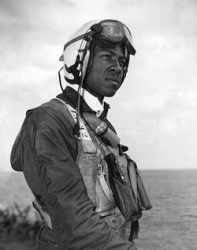
 |
|
|
||
|
Jesse LeRoy Brown |
||||
|
Engagements: • Korean War (1950 - 1953) |
||||
| Biography: | ||||
|
Jesse LeRoy Brown Jesse LeRoy Brown was born on 13 October 1926 in Hattiesburg, MS. After graduating from Ohio State University, Brown accepted an appointment as a midshipman in the U.S. Navy. He completed his Navy pre-flight training at Ottumwa, IA, followed with flight training at Pensacola and Jacksonville, FL. He was designated a Naval Aviator and received his wings as the Navy's first African-American pilot on 21 October 1948. Brown then joined Fighter Squadron 32 on the aircraft carrier USS Wright, (CVL-49) and was commissioned an Ensign on 15 April 1949. His squadron later embarked on carrier USS Leyte (CV-32) and joined Fast Carrier Task Force 77 in support of the United Nations Forces in Korea in October 1950. As a pilot of Fighter Squadron 32, Ensign Brown became a Section Leader and received the Air Medal for daring attacks against the enemy at Wonsan, Chongjin, Songjin, and Sinanju. Leading his section in the face of hostile anti-aircraft fire, he courageously pressed home attacks that inflicted heavy losses on the enemy and provided effective support for friendly ground troops. On 4 December 1950, while aggressively providing close air support to the U.S. Marines fighting near the Chosin Reservoir, his Corsair aircraft was struck by enemy fire. It lost power and he had to crash-land it. His squadron mate, Captain (then Lieutenant, junior grade) Thomas J. Hudner, crash-landed his plane near Brown's aircraft in a heroic rescue attempt (for his efforts Hudner was awarded the Medal of Honor). Lieutenant Hudner was unable to free Brown, who was badly injured in the crash and whose leg was stuck between the crumpled fuselage and hydraulic control panel of his aircraft. After 45 minutes, Marine First Lieutenant Charlie Ward arrived in a rescue helicopter but he and Hudner were still unable to free Brown. Having to depart at dusk since the helicopter was not equipped to fly at night, Ensign Brown told Hudner that if he did not survive, to tell his wife Daisy how much he loved her. Prior to his departure, Hudner spoke to Brown, but got no response. Weather prevented any return to the site until 7 December. Since the site was in enemy territory, Hudner recommended against a helicopter mission with a flight surgeon to extricate Brown's body. He recommended a flyover, during which time Brown's body was seen still in the cockpit of the Corsair, but stripped of all clothing, evidence of the desperation of local Koreans for clothing items. The pilots, all of whom knew Brown, dropped napalm on his and Hudner's aircraft. Today, the rusted hulks of the aircraft can still be seen from observation satellites (Latitude 40 degrees, 36' N, Longitude 127 degrees 06). Ensign Brown was posthumously awarded the Distinguished Flying Cross. The frigate USS Jesse L. Brown (DE/FF/FFT-1089) was named by the Navy in his honor. Death Ensign Jesse LeRoy Brown was killed in action on 4 December 1950 in Korea. His body could not be recovered and was destroyed when his fellow pilots dropped napalm on his and Hudner's aircraft to prevent them from the hands of the enemy. Ensign Brown was the first black naval officer to lose his life in combat during the Korean War. |
||||
| Honoree ID: 2288 | Created by: MHOH | |||
Ribbons
Medals
Badges
Honoree Photos
 |  |  |
 |  |
 |


